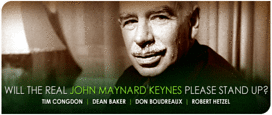After Tim Congdon’s response to my earlier piece, I am a bit confused what we are debating. First, to finish up the simplest point, Congdon’s original post expressed unhappiness about President Obama’s $800 billion a year fiscal stimulus. I pointed out that it was actually closer to $300 billion a year. Now Congdon has come back with data from the International Monetary Fund showing the structural deficit was almost $800 billion higher in 2011 than in 2007.
That’s fine, except that most of the increase in the structural deficit (measured as a share of GDP) came in 2008, under President Bush’s watch. Fiscal 2009 began in October of 2008, which means that one-third of the fiscal year was over before President Obama entered the White House. I don’t work for President Obama, and furthermore I am not troubled by someone raising the deficit in response to an economic collapse, but I just don’t understand the logic of his assertion: “In that sense they [the Obama administration] did endorse a fiscal boost that amounted to almost $800 billion, at an annual rate, relative to the last recession-free year of 2007.” Most of this boost was the result of President Bush’s policies.
I referred in my original note to research that indicated the stimulus was as effective as, or even somewhat more effective than, had been predicted. Congdon responds by saying:
Like Milton Friedman, I reject this sort of analysis. As Friedman said in a 1996 … “I believe it to be true…that the Keynesian view that a government deficit is stimulating is simply wrong. A deficit is not stimulating because it has to be financed, and the negative effects of financing it counterbalance the positive effects, if there are any, on spending.”
Here Congdon seems to telling us as an article of faith that a stimulus can’t be effective, and thus he rejects the evidence that finds substantial job creation.
But the next paragraph gives us a somewhat more measured, “I wouldn’t deny that an increase in the budget deficit financed by new money creation increases equilibrium national income.” Okay, so now we do have a fiscal stimulus adding jobs, when done in conjunction with monetary policy. Of course I don’t know any Keynesians who were not advocating aggressive monetary policy in conjunction with the fiscal stimulus, so I fail to see the point of the objection that Congdon apparently considers so important. When we have people who are suffering from involuntary unemployment, the government should use every tool at its disposal to get them back to work.
I would argue that in the conditions we had in 2009–10 a fiscal stimulus even without further monetary expansion by the Fed would have been expansionary, but obviously it would be more expansionary with the additional boost from the Fed. Of course we do run into a problem here in what we consider expansion by the Fed.
By increasing loan demand, the stimulus would have reduced the $1.6 trillion in excess reserves held by the banking system leading to an increase in M1, M2, M3 and any other monetary aggregates that we might care to invent. I suppose we could call this expansionary monetary policy, but in reality this is the endogenous response of the money supply to growth in the economy.
This gets back to the point that Congdon asserts:
The Great Recession–like the Great Depression–was the result of adverse monetary trends… the Great Recession was caused by a sudden halt in money growth in late 2008. That sudden halt was due to central banks’ and regulators’ misplaced zeal as they hurried to make the bankers much safer .
My recollection was that the halt in money growth was due to banks collapsing because they were insolvent. I suppose that we could have suspended banking regulations completely and regulators could have shown even more forbearance than they did, but the proximate cause of the “halt in money growth” was the fallout from the collapse of the housing bubble, not the evildoing of the Fed. (My story of the Fed’s evildoing was that it did not take steps to burst the bubble in the years 2002–06, before it became so dangerous, but that is another story.)
Finally we are having a strange debate about what is an outcome variable and what is directly under the control of the Fed. Congdon argues that M3 is directly under the control of the Fed but dismisses the idea that an inflation target can be. In fact, the relationship of the two is similar. The Fed controls the monetary base, and how this translates into M2 or M3 depends on the willingness of the banking system to make loans. Of course the Fed can counteract an unwillingness to make loans by enlarging the monetary base to the point where it will eventually hit its target.
Similarly, the Fed can keep throwing money into the system until it hits an inflation target. The idea of inflation targeting should not sound that strange; most central banks in the world now formally do it. The only issue is whether it makes sense to deliberately set a higher inflation target to lower real interest rates and alleviate debt burdens. If there is a serious downside to this policy, I haven’t heard it.

